Izak Botha's Blog, page 3
September 25, 2017
25-09-2017 Semi Finalist – Booklife Prize 2017

Blood Symbols has advanced to Semi Finalist in the renowned Publishers Weekly’s, Booklife Prize -2017. With 10 out of 10 scores throughout, who could have asked for more.
Booklife Prize – 2017
Blood Symbols

SEMI FINALIST
Plot/Idea: 10 out of 10
Originality: 10 out of 10
Prose: 10 out of 10
Character/Execution: 10 out of 10
Overall: 10 out of 10
Assessment:
Plot: The author provides a captivating plot that takes the reader deep into the Vatican, revealing secrets that those in power wish to remain buried. The resulting quest will keep readers on their toes until the end.
Prose: This well-written novel offers the perfect balance of action, description, and character insight. Thanks to great prose, the plot unfolds at a good pace, keeping reader interest but also providing the background necessary to understand the intricate issues at play.
Originality: Inevitably, all mysteries centering on this topic will be reminiscent of The DaVinci Code. Once the reader digs further, however, the story here is strikingly distinctly different and original.
Character Development: The author does a superb job creating a likable protagonist in Jennifer Jaine, Other characters are equally well presented and realistic.
Blurb: This fast-paced and intriguing work will hook readers from the first page to the last, leaving them wanting more.
Semi Finalist: Booklife Prize-2017

Blood Symbols has advanced to Semi Finalist in the renowned Publishers Weekly’s, Booklife Prize -2017. With 10 out of 10 scores throughout, who could have asked for more.
Booklife Prize – 2017
Blood Symbols

SEMI FINALIST
Plot/Idea: 10 out of 10
Originality: 10 out of 10
Prose: 10 out of 10
Character/Execution: 10 out of 10
Overall: 10 out of 10
Assessment:
Plot: The author provides a captivating plot that takes the reader deep into the Vatican, revealing secrets that those in power wish to remain buried. The resulting quest will keep readers on their toes until the end.
Prose: This well-written novel offers the perfect balance of action, description, and character insight. Thanks to great prose, the plot unfolds at a good pace, keeping reader interest but also providing the background necessary to understand the intricate issues at play.
Originality: Inevitably, all mysteries centering on this topic will be reminiscent of The DaVinci Code. Once the reader digs further, however, the story here is strikingly distinctly different and original.
Character Development: The author does a superb job creating a likable protagonist in Jennifer Jaine, Other characters are equally well presented and realistic.
Blurb: This fast-paced and intriguing work will hook readers from the first page to the last, leaving them wanting more.
September 14, 2017
14-09-2017 Holy Bible: Codex Vaticanus
The Vatican’s Secret Archives Library holds one of the oldest copies of the Bible: The Codex Vaticanus.
For the Holy See, State of the Vatican City and home of the Bishop of Rome, the Vaticanus is the inspired and transmitted Word of God, the most precious of all the manuscripts in the world and the source of other translations of the Bible. Together with Saint Peter’s remains, the Vaticanus represents infallible proof that the Kingdom of Heaven resides with the Bishop of Rome and the Holy See; no-one can go to Heaven without their blessing.
Despite the Vatican’s claim that the mid-fourth century Codex Vaticanus is the oldest full transcript of the New Testament, the real contender for the title is the early-fourth century, Codex Sinaiticus. Third in line and dating around the fifth century is the Codex Alexandrinus. A fourth codex rumored to have been found in Turkey recently, which may also date from the fifth century, refutes Jesus’ crucifixion and denies His Sonship of God, but grants Him the status of prophet, while Saint Paul is considered an imposter. No wonder the Vatican is keen to gain access to this codex!
Although it originates earlier, the Vaticanus has only been with the Vatican since the fifteenth century. With at least three revisions to the text since its discovery, it is impossible to say which part of the codex is untouched. It is also unclear where the Vaticanus originates. Some think Asia Minor, others Egypt, and even Rome has been suggested. Using codices like the Sinaiticus, the Alexandrinus, and the Latin Vulgate, folios at the beginning and the end have been substituted. Despite the Vaticanus in parts being a copy of other texts, none of the texts mentioned, neither the Vaticanus, Sinaiticus, Alexandrinus, nor Vulgate, date from the time of Jesus or his Apostles.
Nobody knows who wrote the Gospels. The earliest snippets of Gospel text date from around 200 CE. From the contents, scholars estimate the primary authorship to date around 65 and 125 CE, making it virtually impossible for the Apostles to have written them. Paul’s Epistles were written before the Gospels and Acts. Original Epistles could have been authored as early as 45 to 60 CE. Of the thirteen letters and the latter part of Acts dedicated to Paul, six could be ascribed to him. The rest are so different, they could not have come from the same city, let alone the pen of one man.
In conclusion, it would appear the Codex Vaticanus is not authentic, but is a copy of other copies and/or texts no longer in existence. The extent to which it differs from original scripts is significant, considering its status. But since original documents do not exist, the authors are unknown, and other texts found over time contradict the privileged rendering of the Holy Roman Catholic Church, the Vatican, who asserts the Vaticanus’ status as the Word of the One, True God, is up for scrutiny.
Holy Bible: Codex Vaticanus
The Vatican’s Secret Archives Library holds one of the oldest copies of the Bible: The Codex Vaticanus.
For the Holy See, State of the Vatican City and home of the Bishop of Rome, the Vaticanus is the inspired and transmitted Word of God, the most precious of all the manuscripts in the world and the source of other translations of the Bible. Together with Saint Peter’s remains, the Vaticanus represents infallible proof that the Kingdom of Heaven resides with the Bishop of Rome and the Holy See; no-one can go to Heaven without their blessing.
Despite the Vatican’s claim that the mid-fourth century Codex Vaticanus is the oldest full transcript of the New Testament, the real contender for the title is the early-fourth century, Codex Sinaiticus. Third in line and dating around the fifth century is the Codex Alexandrinus. A fourth codex rumored to have been found in Turkey recently, which may also date from the fifth century, refutes Jesus’ crucifixion and denies His Sonship of God, but grants Him the status of prophet, while Saint Paul is considered an imposter. No wonder the Vatican is keen to gain access to this codex!
Although it originates earlier, the Vaticanus has only been with the Vatican since the fifteenth century. With at least three revisions to the text since its discovery, it is impossible to say which part of the codex is untouched. It is also unclear where the Vaticanus originates. Some think Asia Minor, others Egypt, and even Rome has been suggested. Using codices like the Sinaiticus, the Alexandrinus, and the Latin Vulgate, folios at the beginning and the end have been substituted. Despite the Vaticanus in parts being a copy of other texts, none of the texts mentioned, neither the Vaticanus, Sinaiticus, Alexandrinus, nor Vulgate, date from the time of Jesus or his Apostles.
Nobody knows who wrote the Gospels. The earliest snippets of Gospel text date from around 200 CE. From the contents, scholars estimate the primary authorship to date around 65 and 125 CE, making it virtually impossible for the Apostles to have written them. Paul’s Epistles were written before the Gospels and Acts. Original Epistles could have been authored as early as 45 to 60 CE. Of the thirteen letters and the latter part of Acts dedicated to Paul, six could be ascribed to him. The rest are so different, they could not have come from the same city, let alone the pen of one man.
In conclusion, it would appear the Codex Vaticanus is not authentic, but is a copy of other copies and/or texts no longer in existence. The extent to which it differs from original scripts is significant, considering its status. But since original documents do not exist, the authors are unknown, and other texts found over time contradict the privileged rendering of the Holy Roman Catholic Church, the Vatican, who asserts the Vaticanus’ status as the Word of the One, True God, is up for scrutiny.
September 7, 2017
07-09-2017 Misrepresentation
Blood Symbols, as a religious conspiracy thriller, falls in the same genre as Dan Brown’s, The Da Vinci Code. With Brown’s work setting a genre benchmark and the expectation that subsequent authors would attempt to ride the wave of his success, one must be circumspect in mentioning this successful author’s name when presenting one’s own work.
That said, Blood Symbols does fall into the same genre, and for a substantial portion of the book is also set in the Vatican. But fortunately for Blood Symbols there are a number of distinct differences, rendering the novel unique and fresh. As the Booklife Prize-2017 review by Publishers Weekly points out: “Inevitably, all mysteries centering on this topic will be reminiscent of The Da Vinci Code. Once the reader digs further, however, the story here (Blood Symbols) is strikingly distinctly different and original.”
What then about Blood Symbols is new?
The Da Vinci Code, is set in the time-frame of Jesus: dealing with questions of His possible marriage and the identity of His spouse; was she the Holy Grail; and did she and Jesus have offspring. While Blood Symbols covers the time of the Apostles: did they become the first Christians; did Peter convert Antiochene gentiles to the faith; and did his ministry culminate in Rome as the first pope.
Christianity, contrary to popular belief, did not originate in Judea. Neither did it ensue in the time of Jesus. Christianity originated in Antioch, Turkey, when Saul from Tarsus, a persecutor of Jews, converted Romans to his rendering of the Nazarene faith. The lack of Nazarene backing soon proved an obstacle for the growing gentile church, which in the fourth century became the Roman Empire’s official religion. The Nazarenes, however, who under the leadership of Apostle Peter had received the power and authority of God from Jesus, regarded the Roman Church as phony—an epithet, which did not sit well with the mighty Roman Empire.
To appropriate the power and authority of God for Rome, the Roman Church invented a link between itself and Apostle Peter. The supposed connection originates with the Roman citizen, Saul from Tarsus, where, in Antioch, he was busy converting gentiles to his perverted version of the faith. Peter challenged this and Saul summoned him to iron out their differences, an event known as “the incident of Antioch”, the outcome of which is unknown. To clinch the deal of legitimacy for Rome, in 325AD the Emperor Constantine called the Roman bishops to Nicaea for council. It is here that Christianity as an institution under one roof was born, sealing it as the official religion of the Roman Empire.
The Jewish followers of Christ, the Nazarenes, had no part in the establishment of Christianity for Rome. The Roman Catholic Church, and therefore Christianity in its entirety, is the work of Paul (formerly Saul), who laid the trail for Constantine, a skillful politician and sun worshiper, to appropriate the power and authority of God for Rome. And so, despite numerous breakaway factions, it remains to this day.
Christianity is based on the New Testament scriptures of the Bible, which consist of Canonical Gospels credited to the Apostles of Jesus, letters by the self-appointed apostle Paul, and other individuals’ works. The texts record the life and times of Jesus of Nazareth and his disciples, who were known as the Apostles after Jesus’ crucifixion. The Epistles of Paul, provide insights into the beliefs and conflicts of early Christianity, and which also lays the foundation for Christian theology and ethics as we know them today.
To cement Christianity’s place as the world’s foremost religion and to legitimize Rome’s status as the recipient of God’s power and authority, historical accounts were invented. However, since none of the scriptures date from the time of the actual events, and since none could have come from the hands of the people bearing their names, it is impossible to verify this information. As the Holy Roman Catholic Church spread across the world, the fabrications became ‘fact’. There is probably little that is true about the disseminated history of the Church. For legitimacy, the Church relies on holy traditions: unverified claims—broadcast as truth by the Church.
To separate fact from fiction is impossible. But to separate what is scriptural, from what is not, is possible. Dealing only with the time of the Apostles, what follows are some of the misrepresentations of the Holy Roman Catholic Church regarding its origins:
Christianity starts with Jesus.
Christianity’s history originates with the story of the Galilean, Jesus. Christianity as an organized religion, however, is traced back to Paul in Antioch where his gentile converts were dubbed Christians.
Saul persecuted Christians.
There were no Christians at the time that Saul persecuted Jews in Judea. Furthermore, the Jews who followed Jesus never became Christians, but remained true to the precepts of the Nazarenes.
Saul from Tarsus was a Jew.
Saul was a Roman first and foremost. No Jew could persecute other Jews in Judea. The area was occupied by Rome, and governed by Pontius Pilate, the appointed prefect. Persecutors of Jews must have been Roman.
The Jews accepted Saul’s ministry in Antioch.
The Jews rejected Saul in Antioch, going so far as to stone him. Christianity from here on in was exclusively gentile. Rome, governed by Emperor Constantine in the fourth century, declared the Catholic Christian faith to be the official religion of the Roman empire.
The Jews crucified Jesus.
The Jews did not persecute or crucify Jesus. That, despite beliefs that Pontius Pilot had given Jesus back to the Jews for His trial and subsequent crucifixion, was the work of Romans. Calling for tax collectors to stop collecting taxes and follow Him (Jesus) was a grave violation of Roman justice, punishable by death. Jesus had, on more than one occasion, called on Roman tax collectors to cease their business and follow Him. This defiance left Rome with no option but to sentence him to death.
The disciples of Jesus were Christians.
The Jews who followed Jesus, which, of course, include the disciples of Christ, did not become Christian, but remained members of the Nazarene sect.
Jesus confronts Saul on his way to Damascus
Jesus, confronting Saul from heaven comes from the latter’s own testimony and, quite frankly, is stretching the imagination. If anything, the scripture quoting Jesus as saying: “Saul, why are you persecuting me…”, if at all, likely happened before Jesus’ crucifixion.
Paul converts to Christianity on his way to Damascus
Three things are wrong here: Paul was still Saul at the time; there is no record of Saul’s (or Paul’s) conversion; Saul did not convert to the faith, he invented it nearly a decade later in Antioch.
Saul, prior to his ministry, meets with the disciples of Jesus
There is no record of interaction with the disciples before Saul’s ministry. After his legendary Damascus visitation, Saul disappears for nearly a decade. When he reappears in Antioch, he attempts to preach to the Jews. They stone him, forcing him to turn to the gentiles instead.
Apostle Peter ministered to the gentiles in Antioch before Saul, paving the way for Saul to follow in his footsteps.
Apostle Peter’s ministry to the gentiles in Antioch is crucial to legitimize the Bishop of Rome’s apostolic succession. It lays the foundation for Rome having Peter as its founder of gentile Christianity. There is, however, no evidence that corroborates Peter paving the way for either Saul or Christianity.
Apostle Peter accepts Saul’s ministry to the gentiles
Saul’s ministry led to a protest from Peter, whose practice was to accept gentiles only if they were baptized in the name of the Lord, kept the Laws of Moses, and were circumcised. Peter was summoned by Saul to meet him in Antioch; the outcome of which is unknown. Peter’s trail goes cold after this, but Saul’s career, after changing his name to Paul, flourishes. Hell-bent on establishing a ministry and ignoring the Apostles’ teachings, Paul turns to the Roman gentiles. Thus, Paul’s ministry lays the foundations for the Roman Catholic Church.
Apostle Peter and fellow disciples adopt Saul’s doctrine of faith.
The Nazarenes did not adopt Paul’s ministry, especially not one based on faith alone. James, Jesus’ half-brother, is recorded as insisting that salvation depends on good works as well as faith. Centuries later, the Nazarene Jews still only acknowledge the Gospels, rejecting the Epistles of Paul. The Nazarene movement continued until Epiphanius, bishop of Salamis, Cyprus, declared them heretics in the fourth century, forcing them underground.
The Apostles convert gentiles to Christianity.
The Apostles were not Christians. Non-Jews, however, could covert to the Nazarene faith if they kept the Laws of Moses and succumbed to circumcision. Paul’s Christians and Apostle Peter’s Nazarenes remained antagonistic denominations; there is no evidence of reconciliation.
Apostle Peter ministered and was martyred in Rome.
Other than Catholic tradition and a handful of bones found in a twentieth century dig by Vatican archaeologist that could have belonged to anyone, there is no evidence to corroborate Peter’s presence in Rome. Peter’s ministry in Rome is the final requisite in establishing apostolic succession for the Bishop of Rome. But there is no evidence the Apostle ministered in Rome. We do however find circumstantial evidence in the New Testament that Peter did not minister in Rome.
Apostle Peter was the first pope of Rome.
Other than Catholic tradition, no evidence of Peter even making it to Rome exists. As a staunch Jew holding onto age-old Jewish tradition, it is unlikely that Peter would even have been allowed to become the head of an emerging religion in Rome. Paul, we know, did end up ministering in Rome, and since Paul, a Roman citizen previously endorsed by Pontius Pilot, by his own admission would not preach where someone else had already preached, Peter could not have been in Rome.
Apostle Peter bestowed the power and authority of God onto the second pope, Linus.
A Jew, probably with children, who never ministered in Rome, giving the power and authority of God invested in him to a Roman in Rome—impossible! There is no evidence corroborating such.
Apostle Peter is martyred in Rome, crucified up-side-down.
Peter’s trail goes cold after Antioch. If anything, he, as was the case with Jesus, came to an untimely death. If so, it could have been around the time of his meeting with Saul and possibly in the area.
The Jews rejected Jesus as the Messiah, therefore the gentile Catholic Church of Rome became the new throne of God.
The reason for all the conspiracy in fourth century Rome, was to consolidate, rid itself of contradictory religions, and establish gentile Christianity as the world’s foremost religion—the seat of God’s throne. Many original texts were destroyed, while a few—of which only copies survive today—were kept as a basis for doctrine. The rest came about through tradition, at times defended by declaring those who oppose the mendacious ‘truths’ to be heretics, burning them at the stake. With the goal of establishing Christianity as the world religion with the seat of God residing at the Vatican, the Roman authorities, three-and-a-half centuries after the crucifixion of Jesus, invented Apostle Peter’s ministry in Rome, claiming he had passed God’s power and authority to the newly formed church in Rome.
Misrepresentation
Blood Symbols, as a religious conspiracy thriller, falls in the same genre as Dan Brown’s, The Da Vinci Code. With Brown’s work setting a genre benchmark and the expectation that subsequent authors would attempt to ride the wave of his success, one must be circumspect in mentioning this successful author’s name when presenting one’s own work.
That said, Blood Symbols does fall into the same genre, and for a substantial portion of the book is also set in the Vatican. But fortunately for Blood Symbols there are a number of distinct differences, rendering the novel unique and fresh. As the Booklife Prize-2017 review by Publishers Weekly points out: “Inevitably, all mysteries centering on this topic will be reminiscent of The Da Vinci Code. Once the reader digs further, however, the story here (Blood Symbols) is strikingly distinctly different and original.”
What then about Blood Symbols is new?
The Da Vinci Code, is set in the time-frame of Jesus: dealing with questions of His possible marriage and the identity of His spouse; was she the Holy Grail; and did she and Jesus have offspring. While Blood Symbols covers the time of the Apostles: did they become the first Christians; did Peter convert Antiochene gentiles to the faith; and did his ministry culminate in Rome as the first pope.
Christianity, contrary to popular belief, did not originate in Judea. Neither did it ensue in the time of Jesus. Christianity originated in Antioch, Turkey, when Saul from Tarsus, a persecutor of Jews, converted Romans to his rendering of the Nazarene faith. The lack of Nazarene backing soon proved an obstacle for the growing gentile church, which in the fourth century became the Roman Empire’s official religion. The Nazarenes, however, who under the leadership of Apostle Peter had received the power and authority of God from Jesus, regarded the Roman Church as phony—an epithet, which did not sit well with the mighty Roman Empire.
To appropriate the power and authority of God for Rome, the Roman Church invented a link between itself and Apostle Peter. The supposed connection originates with the Roman citizen, Saul from Tarsus, where, in Antioch, he was busy converting gentiles to his perverted version of the faith. Peter challenged this and Saul summoned him to iron out their differences, an event known as “the incident of Antioch”, the outcome of which is unknown. To clinch the deal of legitimacy for Rome, in 325AD the Emperor Constantine called the Roman bishops to Nicaea for council. It is here that Christianity as an institution under one roof was born, sealing it as the official religion of the Roman Empire.
The Jewish followers of Christ, the Nazarenes, had no part in the establishment of Christianity for Rome. The Roman Catholic Church, and therefore Christianity in its entirety, is the work of Paul (formerly Saul), who laid the trail for Constantine, a skillful politician and sun worshiper, to appropriate the power and authority of God for Rome. And so, despite numerous breakaway factions, it remains to this day.
Christianity is based on the New Testament scriptures of the Bible, which consist of Canonical Gospels credited to the Apostles of Jesus, letters by the self-appointed apostle Paul, and other individuals’ works. The texts record the life and times of Jesus of Nazareth and his disciples, who were known as the Apostles after Jesus’ crucifixion. The Epistles of Paul, provide insights into the beliefs and conflicts of early Christianity, and which also lays the foundation for Christian theology and ethics as we know them today.
To cement Christianity’s place as the world’s foremost religion and to legitimize Rome’s status as the recipient of God’s power and authority, historical accounts were invented. However, since none of the scriptures date from the time of the actual events, and since none could have come from the hands of the people bearing their names, it is impossible to verify this information. As the Holy Roman Catholic Church spread across the world, the fabrications became ‘fact’. There is probably little that is true about the disseminated history of the Church. For legitimacy, the Church relies on holy traditions: unverified claims—broadcast as truth by the Church.
To separate fact from fiction is impossible. But to separate what is scriptural, from what is not, is possible. Dealing only with the time of the Apostles, what follows are some of the misrepresentations of the Holy Roman Catholic Church regarding its origins:
Christianity starts with Jesus.
Christianity’s history originates with the story of the Galilean, Jesus. Christianity as an organized religion, however, is traced back to Paul in Antioch where his gentile converts were dubbed Christians.
Saul persecuted Christians.
There were no Christians at the time that Saul persecuted Jews in Judea. Furthermore, the Jews who followed Jesus never became Christians, but remained true to the precepts of the Nazarenes.
Saul from Tarsus was a Jew.
Saul was a Roman first and foremost. No Jew could persecute other Jews in Judea. The area was occupied by Rome, and governed by Pontius Pilate, the appointed prefect. Persecutors of Jews must have been Roman.
The Jews accepted Saul’s ministry in Antioch.
The Jews rejected Saul in Antioch, going so far as to stone him. Christianity from here on in was exclusively gentile. Rome, governed by Emperor Constantine in the fourth century, declared the Catholic Christian faith to be the official religion of the Roman empire.
The Jews crucified Jesus.
The Jews did not persecute or crucify Jesus. That, despite beliefs that Pontius Pilot had given Jesus back to the Jews for His trial and subsequent crucifixion, was the work of Romans. Calling for tax collectors to stop collecting taxes and follow Him (Jesus) was a grave violation of Roman justice, punishable by death. Jesus had, on more than one occasion, called on Roman tax collectors to cease their business and follow Him. This defiance left Rome with no option but to sentence him to death.
The disciples of Jesus were Christians.
The Jews who followed Jesus, which, of course, include the disciples of Christ, did not become Christian, but remained members of the Nazarene sect.
Jesus confronts Saul on his way to Damascus
Jesus, confronting Saul from heaven comes from the latter’s own testimony and, quite frankly, is stretching the imagination. If anything, the scripture quoting Jesus as saying: “Saul, why are you persecuting me…”, if at all, likely happened before Jesus’ crucifixion.
Paul converts to Christianity on his way to Damascus
Three things are wrong here: Paul was still Saul at the time; there is no record of Saul’s (or Paul’s) conversion; Saul did not convert to the faith, he invented it nearly a decade later in Antioch.
Saul, prior to his ministry, meets with the disciples of Jesus
There is no record of interaction with the disciples before Saul’s ministry. After his legendary Damascus visitation, Saul disappears for nearly a decade. When he reappears in Antioch, he attempts to preach to the Jews. They stone him, forcing him to turn to the gentiles instead.
Apostle Peter ministered to the gentiles in Antioch before Saul, paving the way for Saul to follow in his footsteps.
Apostle Peter’s ministry to the gentiles in Antioch is crucial to legitimize the Bishop of Rome’s apostolic succession. It lays the foundation for Rome having Peter as its founder of gentile Christianity. There is, however, no evidence that corroborates Peter paving the way for either Saul or Christianity.
Apostle Peter accepts Saul’s ministry to the gentiles
Saul’s ministry led to a protest from Peter, whose practice was to accept gentiles only if they were baptized in the name of the Lord, kept the Laws of Moses, and were circumcised. Peter was summoned by Saul to meet him in Antioch; the outcome of which is unknown. Peter’s trail goes cold after this, but Saul’s career, after changing his name to Paul, flourishes. Hell-bent on establishing a ministry and ignoring the Apostles’ teachings, Paul turns to the Roman gentiles. Thus, Paul’s ministry lays the foundations for the Roman Catholic Church.
Apostle Peter and fellow disciples adopt Saul’s doctrine of faith.
The Nazarenes did not adopt Paul’s ministry, especially not one based on faith alone. James, Jesus’ half-brother, is recorded as insisting that salvation depends on good works as well as faith. Centuries later, the Nazarene Jews still only acknowledge the Gospels, rejecting the Epistles of Paul. The Nazarene movement continued until Epiphanius, bishop of Salamis, Cyprus, declared them heretics in the fourth century, forcing them underground.
The Apostles convert gentiles to Christianity.
The Apostles were not Christians. Non-Jews, however, could covert to the Nazarene faith if they kept the Laws of Moses and succumbed to circumcision. Paul’s Christians and Apostle Peter’s Nazarenes remained antagonistic denominations; there is no evidence of reconciliation.
Apostle Peter ministered and was martyred in Rome.
Other than Catholic tradition and a handful of bones found in a twentieth century dig by Vatican archaeologist that could have belonged to anyone, there is no evidence to corroborate Peter’s presence in Rome. Peter’s ministry in Rome is the final requisite in establishing apostolic succession for the Bishop of Rome. But there is no evidence the Apostle ministered in Rome. We do however find circumstantial evidence in the New Testament that Peter did not minister in Rome.
Apostle Peter was the first pope of Rome.
Other than Catholic tradition, no evidence of Peter even making it to Rome exists. As a staunch Jew holding onto age-old Jewish tradition, it is unlikely that Peter would even have been allowed to become the head of an emerging religion in Rome. Paul, we know, did end up ministering in Rome, and since Paul, a Roman citizen previously endorsed by Pontius Pilot, by his own admission would not preach where someone else had already preached, Peter could not have been in Rome.
Apostle Peter bestowed the power and authority of God onto the second pope, Linus.
A Jew, probably with children, who never ministered in Rome, giving the power and authority of God invested in him to a Roman in Rome—impossible! There is no evidence corroborating such.
Apostle Peter is martyred in Rome, crucified up-side-down.
Peter’s trail goes cold after Antioch. If anything, he, as was the case with Jesus, came to an untimely death. If so, it could have been around the time of his meeting with Saul and possibly in the area.
The Jews rejected Jesus as the Messiah, therefore the gentile Catholic Church of Rome became the new throne of God.
The reason for all the conspiracy in fourth century Rome, was to consolidate, rid itself of contradictory religions, and establish gentile Christianity as the world’s foremost religion—the seat of God’s throne. Many original texts were destroyed, while a few—of which only copies survive today—were kept as a basis for doctrine. The rest came about through tradition, at times defended by declaring those who oppose the mendacious ‘truths’ to be heretics, burning them at the stake. With the goal of establishing Christianity as the world religion with the seat of God residing at the Vatican, the Roman authorities, three-and-a-half centuries after the crucifixion of Jesus, invented Apostle Peter’s ministry in Rome, claiming he had passed God’s power and authority to the newly formed church in Rome.
September 3, 2017
03-09-2017 Apostolic Succession
The Bishop of Rome claims uninterrupted apostolic succession from the first pope, Apostle Peter.
Apostolic succession pertains to the spiritual power and authority invested in the original Apostles of Christ, which, through uninterrupted transmission passes on to subsequent popes of the Holy Roman Catholic Church.
The Vatican, as the governing body of the Roman Catholic Church, uses the claim to exclusive succession as evidence of its religious supremacy. According to Catholic teachings, Saint Peter was invested with the power and authority of God prior to the crucifixion of Christ. Peter, before he was himself was martyred, bestowed the powers to the second Roman pope, Linus. This lineage has remained unbroken for two thousand years and presently resides with Pope Francis.
Apostolic succession is based on the following ‘facts’: that the Jews rejected Jesus as the Messiah, that Apostle Peter founded Christianity for the gentiles in Antioch, and that Peter’s ministry was based in Rome. The claim of papal infallibility (in all spiritual pronouncements) is based on the veracity of these assertions; should any be found to be erroneous, the Roman Church would have nothing to support its claim as the one true religion.
As scriptural evidence that God’s power and authority are truly invested in the Bishop of Rome, the Vatican refers to the following:
Gospel of Matthew: God bestowing all power in Heaven and on Earth upon His Son Jesus.
Gospel of John: The Keys of the Kingdom being bestowed upon Christ’s beloved Apostle Peter, whom He instructs to feed His sheep.
Gospel of Matthew: Christ calling Saint Peter the rock upon which he will build his Church, and that whatever Peter binds and loosens on Earth, the same would be honoured in Heaven.
As physical evidence, the Vatican presents the Cave Church of Saint Peter in Antioch, Turkey, as the location where Apostle Peter first converted gentiles to the faith. The aedicula within Saint Peter’s basilica in Rome marks the spot where Peter met his macabre death of inverted crucifixion.
To underscore Peter’s assumed presence in Rome, the Vatican in 1968 announced the discovery of his relics—a handful of bones.
Finally, perhaps as an afterthought, the Vatican in 1983 declares the Antiochene Cave Church of Saint Peter a holy site.
But what if none of this is true?
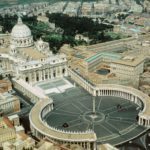
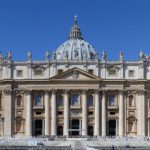
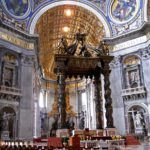

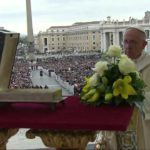
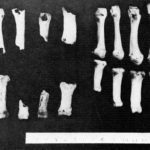


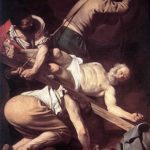
All references to scripture, artwork, artefacts, and architecture in Blood Symbols are accurate.
Apsotolic Succession
The Bishop of Rome claims uninterrupted apostolic succession from the first pope, Apostle Peter.
Apostolic succession pertains to the spiritual power and authority invested in the original Apostles of Christ, which, through uninterrupted transmission passes on to subsequent popes of the Holy Roman Catholic Church.
The Vatican, as the governing body of the Roman Catholic Church, uses the claim to exclusive succession as evidence of its religious supremacy. According to Catholic teachings, Saint Peter was invested with the power and authority of God prior to the crucifixion of Christ. Peter, before he was himself was martyred, bestowed the powers to the second Roman pope, Linus. This lineage has remained unbroken for two thousand years and presently resides with Pope Francis.
Apostolic succession is based on the following ‘facts’: that the Jews rejected Jesus as the Messiah, that Apostle Peter founded Christianity for the gentiles in Antioch, and that Peter’s ministry was based in Rome. The claim of papal infallibility (in all spiritual pronouncements) is based on the veracity of these assertions; should any be found to be erroneous, the Roman Church would have nothing to support its claim as the one true religion.
As scriptural evidence that God’s power and authority are truly invested in the Bishop of Rome, the Vatican refers to the following:
Gospel of Matthew: God bestowing all power in Heaven and on Earth upon His Son Jesus.
Gospel of John: The Keys of the Kingdom being bestowed upon Christ’s beloved Apostle Peter, whom He instructs to feed His sheep.
Gospel of Matthew: Christ calling Saint Peter the rock upon which he will build his Church, and that whatever Peter binds and loosens on Earth, the same would be honoured in Heaven.
As physical evidence, the Vatican presents the Cave Church of Saint Peter in Antioch, Turkey, as the location where Apostle Peter first converted gentiles to the faith. The aedicula within Saint Peter’s basilica in Rome marks the spot where Peter met his macabre death of inverted crucifixion.
To underscore Peter’s assumed presence in Rome, the Vatican in 1968 announced the discovery of his relics—a handful of bones.
Finally, perhaps as an afterthought, the Vatican in 1983 declares the Antiochene Cave Church of Saint Peter a holy site.
But what if none of this is true?









All references to scripture, artwork, artefacts, and architecture in Blood Symbols are accurate.
August 24, 2017
24-08-2017 Wisdom
Growing up as a child, I prayed for wisdom. Inspired by biblical Solomon the Wise, it appeared to me that wisdom was the worthiest gift from God.
Deep within me, something agreed that the pursuit of wisdom surpasses everything. Because Solomon’s wisdom came as a gift from God, in the back of my mind, my wisdom would also come as a gift. God somehow listens from heaven, and if the prayer is sincere He answers by miraculously bestowing on the person the gift of wisdom.
A gift requires no work and no effort though. Or so I had thought. But that soon changed. For some time I felt no different. It was as if God had ignored my prayer. With failure came doubt and a sense of loss. But this was exactly what I needed. With my bubble burst and my self-worth compromised, I started questioning, and with introspection came the realization that perhaps wisdom is not a gift. After what seemed like eons searching for answers around the nature of wisdom, it dawned on me: wisdom comes at a price—it requires knowledge. Yes, the foremost ingredient for wisdom is knowledge. Gaining knowledge however, requires work— lots of it.
My sights firmly set on wisdom, I set out to acquire knowledge. This proved harder than anticipated. Knowledge, I found, is gained through inquiry, discovery, science, philosophy, mathematics, sensory perception, experiment, and evidence. Knowledge needs to be reliable, testable and corroborated. It requires reason and logic. Knowledge also changes with time. It self-corrects and improves in the face of new discoveries. The search for knowledge demands that one relies on the finds of others. No one person can achieve all there is to know on his or her own. To be certain that the claims of others are true, and to ensure one is not taken for a ride, the knowledge of others must be scrutinized.
Yet, when it comes to spiritual matters, the church expects its faithful to choose faith. Rather than empiric knowledge, experiment, and evidence, people must opt for faith when submitting to a religion. Because religion is unchanging and infallible, they are taught not to question. The holy books—the blueprint of most religions—are written by people inspired by the Holy Spirit, and the writings therefore are not open to human challenge. No matter how plausible or convincing the doctrine, and no matter what evidence comes to light, no matter the rhyme or reason, where logic should prevail, the faithful must close ranks and defend their religion from challenge. Once a believer falls into this trap, just about everything becomes an article of faith. How to change this irrational approach?
Wisdom, for me, is applied knowledge. As with Solomon, God bestows wisdom on those who earnestly seek knowledge. Knowledge yields insight, and through application, hopefully wisdom.
My name is Izak Botha and I seek wisdom.
Welcome to my blog.
Wisdom
Growing up as a child, I prayed for wisdom. Inspired by biblical Solomon the Wise, it appeared to me that wisdom was the worthiest gift from God.
Deep within me, something agreed that the pursuit of wisdom surpasses everything. Because Solomon’s wisdom came as a gift from God, in the back of my mind, my wisdom would also come as a gift. God somehow listens from heaven, and if the prayer is sincere He answers by miraculously bestowing on the person the gift of wisdom.
A gift requires no work and no effort though. Or so I had thought. But that soon changed. For some time I felt no different. It was as if God had ignored my prayer. With failure came doubt and a sense of loss. But this was exactly what I needed. With my bubble burst and my self-worth compromised, I started questioning, and with introspection came the realization that perhaps wisdom is not a gift. After what seemed like eons searching for answers around the nature of wisdom, it dawned on me: wisdom comes at a price—it requires knowledge. Yes, the foremost ingredient for wisdom is knowledge. Gaining knowledge however, requires work— lots of it.
My sights firmly set on wisdom, I set out to acquire knowledge. This proved harder than anticipated. Knowledge, I found, is gained through inquiry, discovery, science, philosophy, mathematics, sensory perception, experiment, and evidence. Knowledge needs to be reliable, testable and corroborated. It requires reason and logic. Knowledge also changes with time. It self-corrects and improves in the face of new discoveries. The search for knowledge demands that one relies on the finds of others. No one person can achieve all there is to know on his or her own. To be certain that the claims of others are true, and to ensure one is not taken for a ride, the knowledge of others must be scrutinized.
Yet, when it comes to spiritual matters, the church expects its faithful to choose faith. Rather than empiric knowledge, experiment, and evidence, people must opt for faith when submitting to a religion. Because religion is unchanging and infallible, they are taught not to question. The holy books—the blueprint of most religions—are written by people inspired by the Holy Spirit, and the writings therefore are not open to human challenge. No matter how plausible or convincing the doctrine, and no matter what evidence comes to light, no matter the rhyme or reason, where logic should prevail, the faithful must close ranks and defend their religion from challenge. Once a believer falls into this trap, just about everything becomes an article of faith. How to change this irrational approach?
Wisdom, for me, is applied knowledge. As with Solomon, God bestows wisdom on those who earnestly seek knowledge. Knowledge yields insight, and through application, hopefully wisdom.
My name is Izak Botha and I seek wisdom.
Welcome to my blog.



